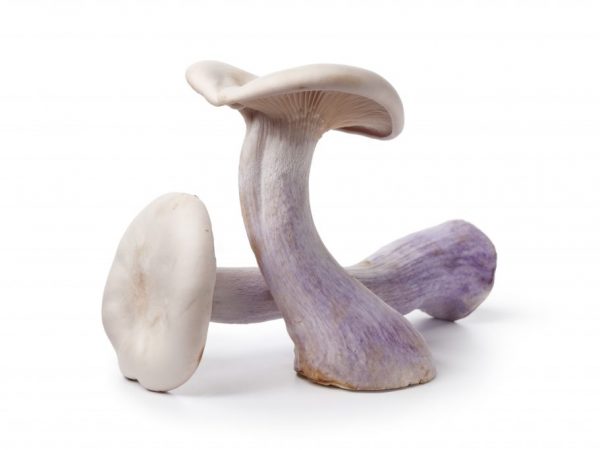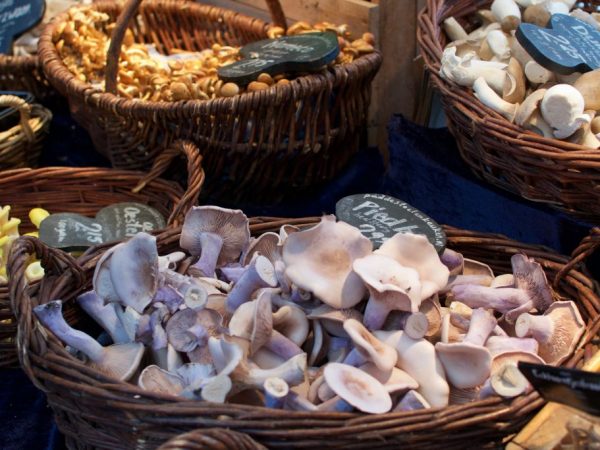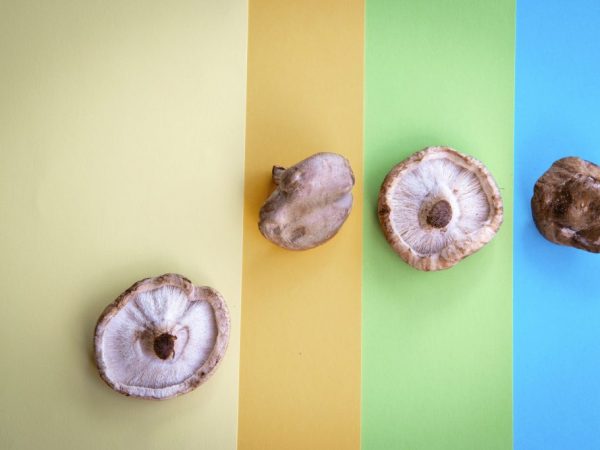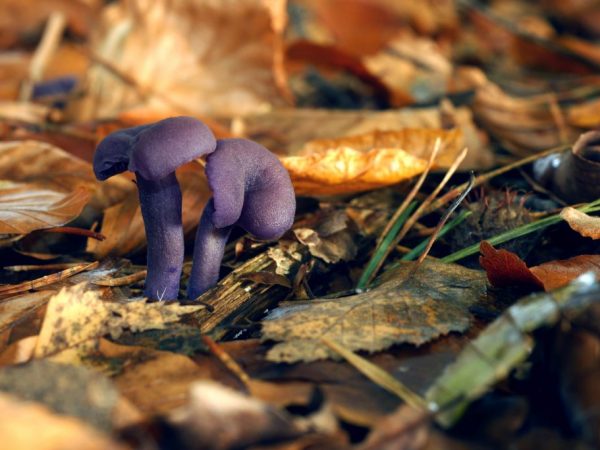Description of the mushroom ryadovka purple
A delicious and beautiful purple ryadovka mushroom causes concern for many, and all thanks to its unusual color. Mushroom pickers with little experience pass by, considering it poisonous. The people call the mushroom differently: "titmouse", lilac ryadovka, naked or violet lepists.

Description of the mushroom ryadovka purple
The appearance of the mushroom
The mushroom has an unusual color: the hat has a bright purple color, which gradually fades with age. The adult mushroom is lavender with a brownish tint. The shape of the cap changes as it grows: first it has a convex, rounded shape, then it opens. The cap of an overripe mushroom is slightly concave inward, the edges are always curved.
The cap of a mature lepista is 6 to 15 cm in size. The top is smooth, shiny, moist, with irregular edges, fleshy and elastic.
The plates under the cap, which form the hymenophore, also have a bright purple color. As they ripen, they become lighter, sometimes the color turns from lilac to pale gray. Spore powder of pink or yellowish-pink color. The spores are ellipsoid-ovoid.
Lepist's leg has a cylindrical shape, slightly thickened at the base. The height is usually 3-8 cm, the diameter is up to 2 cm. The leg is also purple at first, then gradually brightens, smooth to the touch.

Lepists' leg has a cylindrical shape, slightly thickened at the base
In an overripe purple ryadovka, the leg may be hollow, but there are several cavities, its pulp consists of longitudinal fibers. At the very base there is a purple pubescence - it is formed by the mycelium.
According to the description, the pulp has a fruity smell, and the purple ryadovka tastes a little sweet.
Beneficial features
The edible mushroom has valuable vitamins and minerals. It contains manganese, zinc, copper, vitamins B1 and B2. Lepista lilac has antibacterial properties, is capable of anti-inflammatory effects, and supports immunity. Frequent consumption of lepists in food will improve the work of the cardiovascular system, normalize heart rhythms, normalize blood sugar, increase efficiency, and help get rid of chronic fatigue and overwork. The composition contains ergosterol and stearic acid.
The calorie content per 100 g of the product is 19 kcal.
Harm and contraindications
In some countries of the world, purple ryadovka belongs to the category of inedible mushrooms, since its use in its raw form leads to intestinal upset. A little heat treatment is enough for all hazardous substances to be destroyed and the titmouse becomes completely edible.
It is believed that the hemolysin contained in the pulp is to blame for the gastric disorders caused by this type of lepista. It destroys blood cells.
"Titmouse" is easily confused with the following conditionally edible twin mushrooms:
- Webcap purple: in appearance it is absolutely identical with the "titmouse", only the hymenophore plates are covered with a cobweb private veil at the webbed.
- Lilac-footed row: the surface of the leg is covered with chloe-like formations, its pulp is fibrous, but the cap is usually light yellow with a violet tinge, the plates are whitish, later acquire the color of the cap.
- Lilac varnish: This is a small mushroom with a thin stem that has a clearly visible longitudinal striping.
Therefore, it is important to carefully examine the mushrooms at the collection point.
Application
"Titmouses" are delicious, they are used in cooking. The main thing is not to forget to pre-boil the mushrooms in slightly salted water for 15 minutes. After that, they can be added to dishes, fried, dried, pickled.
Row purple perfectly complements vegetable dishes, omelets. In ready-made dishes, it tastes like boiled meat. That is why some housewives choose it for cooking caviar.

Purple row is used in cooking
Mushrooms are kept fresh for about 3 days in the refrigerator. To preserve them for a longer period, they are frozen or salted. This allows you to save the fruiting bodies for 4-6 months. To preserve for a year or longer, they are canned or dried.
Application in medicine
Due to its special qualities, "titmouse" is actively used in medicine. On the basis of the purple row, they develop drugs for diabetes, produce a number of antibiotics that successfully fight tuberculosis. From the mycelium, drugs are being developed that actively fight cancer: sarcoma, cancer of the cervix and breast). Pharmacists also use the mushroom to prepare drugs that lower blood glucose levels and control hypoglycemia.
Preparations based on lepists treat diseases of the genitourinary system, stomach, and liver.
In folk medicine, an alcoholic tincture is made from "blue tits", which allows to treat many skin diseases. Lepista extract helps to cleanse the body, rejuvenate, increase the level of immunity.
In cosmetology, these mushrooms are also used. The facial toner from the rows allows you to successfully fight acne, blackheads, acne, skin irritation and well regulates the production of sebum.
Growing methods
Titmouse grows well:
- in the wild;
- on a personal plot;
- in special rooms or greenhouses.
Lepista is found in various types of forests (coniferous and mixed), as well as in gardens and on compost heaps. She is unpretentious. It grows in the northern regions on deciduous or coniferous-deciduous humus, and therefore is a saprophyte. Small groups are usually met. It happens that you are lucky to run into whole meadows or, as the people call it, "witch circles". Often "titmouses" coexist with a smoky talker.
Irina Selyutina (Biologist):
The word combination "witch circles" has come to us from the depths of centuries. And although modern man knows perfectly well that there is nothing dangerous here, our ancestors were sure that behind this place was hidden any "dark force." Studies of the soil in "witch circles" made it possible to establish that the death of vegetation in its center occurs due to the fact that the mycelium of fungi growing along the perimeter has already taken away all the nutrients. From its "founder" - the mushroom, the mycelium grew evenly in all directions, capturing more and more new areas of the soil and forming a ring. After some time, in the central part, the mycelium dies "from hunger" (let's say) and the mushrooms remain only on the periphery of the circle. Each year, such a ring increases by an average of 10-15 cm.
Harvesting begins in October and ends with the first November frost.
Growing in the garden
They also grow titmouses on their own plot.
Lepista lays the fruit body when the temperature drops to 15 ° C. The most favorable time for planting a crop is May, but it is not forbidden to start growing in the fall.
Stucco is grown in boxes and bags or in beds located in a shady place. There should be a minimum of direct sunlight. After planting the mycelium in the ground, it is provided with maximum moisture, while covering it with polyethylene. Violet ryadovka mycelium develops well at + 20 ° С. The substrate should be monitored regularly: after a couple of weeks, purple mycelium will appear on it.

Titmouse can be grown independently
After that, an earthen layer 5 cm thick is applied on top, and then covered again. After a few more weeks, the mycelium will appear above the ground. After a few more weeks, the first crop will begin to appear. For this, the following conditions must be met: the place must be covered, the temperature must be within + 10 ... + 15 ° С.
Attention! It is very important to maintain normal soil moisture if drying out or, conversely, waterlogging occurs. In this case, a small layer of earth is poured, 0.5 cm. Also, the earth is poured after each harvest.
The purple row is going through the winter perfectly. For a safe wintering, in order to prevent protection from the cold, it is necessary to cover the bed with agromaterial and cover it with a 10-cm layer of insulating material (straw or foliage).
Indoor cultivation
The purple row is successfully grown indoors. This requires good ventilation, illumination, temperature within + 10 ... + 15 ° С and the required level of humidity. The rest of the cultivation technique is the same as outdoors.
There are several reasons for the unsuccessful cultivation of a row in the room, and they are all associated with errors in agricultural technology:
- Too weak ventilation, due to which the fruiting bodies wither, the leg grows thin and long, the cap is small.
- Improper hydration: too little or too much water leads to poor harvest.
- Excessive sunlight will dehydrate the mushrooms.
Irina Selyutina (Biologist):
For the first time, ryadovki began to grow back in the nineteenth century. In France (1898). However, as is often the case, the greatest success is achieved by the followers. So it happened this time too - Holland surpassed the French mushroom growers, using compost, which included horse manure, straw (bark) and superphosphate (chicken droppings) in a ratio of 4: 1: 1.
However, it is possible to use a substrate for mushrooms for cultivation.
Do not forget. No matter how purple rows are grown, after harvesting, they always cut off the contaminated lower part of the leg.
Conclusion
Purple ryadovka is a wonderful edible mushroom, the main thing is to boil it a little in boiling water before use. The pulp has an unusual fruity aroma, sweetish in taste. The mushroom is picky, grows well in the wild, but also lends itself to growing at home. The main condition for a good harvest is moderate humidity.



